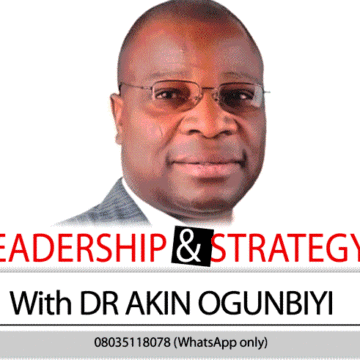The gradual but sure slowdown in the fortunes of an organisation that should be thriving is indicative of dysfunctional leadership, the emblematic debilitating activities of a leader who by default intentionally dims the energy and sparkle of the workplace by not fully engaging the entire team. He is not adaptable and does not encourage and promote sharing of ideas to improve performance. Neither does he spread the critical spirit of entrepreneurship.
He truncates diligent interest and dedicated enthusiasm. He kills career dreams and passion.
Leadership is not just an art but a skill of influence. A tool for influencing the entire workplace with the leader’s ideas for the greater good and organisational success.
The leader’s transformational influence should create a healthy, cohesive and functional (not dysfunctional) organization that is committed to collective results. His style ought to be full engagement by the entire workforce. The goal all the time, should be the achievement of smart outcomes. The organisation must thrive and win always.
He influences his own actions, thoughts, emotions and feelings first before impacting his team members. To achieve limitless possibilities and great accomplishments and also tackle challenges as well as access fresh and counter intuitive solutions, he listens to ideas from his colleagues, chooses the smart ones (ideas) and always soaks in invaluable insights.
His profound impact on abilities of team members engenders learning and thereby, personal growth. His mentoring skills unlock the keys of inner drive, positive mindset and resilience. Every member of staff is influenced and encouraged to embrace a growth mindset not the fixed mindset and also smarter ways of achieving outcomes.
Employees lining up behind the leader because of his authoritarian style does not make him a smart leader. An effective leader must practice structured empowerment. He must champion the sharing of smart ideas to improve performance. His team members must enjoy curated ways to do their work, share ideas and be accountable for value-delivering execution.
The CEO must lead with smart ideas and shared wisdom while also spreading the entrepreneurial spirit. This will make the work and careers of colleagues, keep their luster.
Leadership is earned and the leader must always showcase beneficial coaching in his day-to-day activities. The leader must ask the right questions in order to get the much needed answers. He must be consistent so as not to erode trust. He must always stand with the entire team members and not just the privileged few.
A leader that desires success must foster collaboration and inspire team members to achieve their full potential. As an adaptable leader, he must leverage emotional intelligence, clear communication and strategic vision.
Emotional intelligence or emotional quotient (EQ) enables the leader to adapt to valid and important perspectives. He tells team members always that he appreciates their regular and meaningful contributions.
Emotional Intelligence fosters better decisions and builds stronger connection in the workplace. Advantages of emotional intelligence include: the leader’s self-awareness, adaptability, empathy, assertive communication, self-motivation and conflict resolution skills. EQ makes teammates smarter. The salespeople become world class marketers. It is a great facilitator of smart processes. Cadence of workplace communication and relationship improve as well as enhance individual employee’s competence. The organisation thrives on sharper feedbacks and efficient mapping of deliverables and values.
Results of the poignant transformative influence of the smart CEO are: cohesive and functional organisation as well as effective and efficient value chain.
The distinguishing characterisation or discipline of the healthy organisation is cohesiveness. The leadership team must be behaviorally cohesive. Members must trust one another and regularly allow productive conflict and healthy arguments in the pursuit of truth. There must be commitment and members must always be on the same page on agreed decisions. Accountability must naturally flow from commitment. Members must always have the courage to hold each other accountable for what they have committed to. I also mentioned earlier that efforts must be galvanized towards the achievement of great collective results and goals.
ALSO READ FROM NIGERIAN TRIBUNE: Tinubu surrenders to North-Central as Yilwatda emerges APC national chairman
This skill of achieving a well-structured value chain, the building blocks by which an organisation creates its values to customers, is the core of business strategy. The value chain, an invaluable network of innovative activities, is the strategic tool for differentiation and positioning. The totality of the workforce with their skills and diverse experiences differentiates the organisation from others. The value chain determines how competitive scope impacts the achievement of competitive advantage. How the leader influences this integrated set of activities determines positioning in the market place.
In conclusion, the CEO’S transformative influence must guarantee the right methodology for creative problem-solving with innovative ideas. The entire workforce must be aligned to effectively create outcome-based solutions for customers by collaboratively identifying and defining problems and solutions. Also, the leader must listen before jumping into conclusions and making decisions. There must be deliberate openness. The organisation’s co-created solutions must regularly be achieved with speed and efficiency. Cost effectiveness is also very important. Remember, the leader must support the entire team so that they too can (with dedication) support him in return.
WATCH TOP VIDEOS FROM NIGERIAN TRIBUNE TV
- Let’s Talk About SELF-AWARENESS
- Is Your Confidence Mistaken for Pride? Let’s talk about it
- Is Etiquette About Perfection…Or Just Not Being Rude?
- Top Psychologist Reveal 3 Signs You’re Struggling With Imposter Syndrome
- Do You Pick Up Work-Related Calls at Midnight or Never? Let’s Talk About Boundaries







